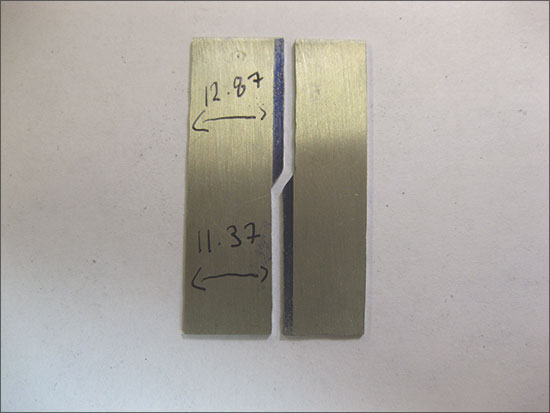Debunking Three Myths About Sawing
In thinking about the daily tasks that I undertake at the bench, I realized how easy it is to fall back on old habits, and to make assumptions and generalizations, particularly about the accuracy of things that I was taught early on in my career. The following are a few myths about one of the most basic procedures at the bench: sawing.
4 Minute Read
It's not uncommon for jewelers to discuss (or, perhaps more accurately, mock) each other's work habits in a group studio environment. Even in shops where people have been working together for years, you'll frequently hear, "What are you doing?" and "Why are you doing that?" The fact that there can be so much dialogue among experienced goldsmiths and bench jewelers makes me wonder, How do I really know that what I am doing is the best approach? Could I be trusting habit, tradition, or superstition?
In thinking about the daily tasks that I undertake at the bench, I realized how easy it is to fall back on old habits, and to make assumptions and generalizations, particularly about the accuracy of things that I was taught early on in my career. The following are a few myths about one of the most basic procedures at the bench: sawing.
Myth
Permanent markers are a great option for quick layout.
Permanent felt-tip makers were everywhere in the studio at the art school where I started my education, and I used them almost daily for simple layout tasks. I used them for years without much thought about how precise they really are. The fact is, using a marker, even a "fine point," turns out to be tremendously inaccurate given the scale of the objects on which we work.
Consider the following scenario: You are cutting a piece of stock to make a ring blank, and you mark your measurement using a straight edge and a standard permanent felt-tip marker. If you measure both the marker and the line it creates (assuming you use the same readily available major brand that I do), you will find that its tip is almost 4 mm wide, and the mark that it makes is almost 1.5 mm wide. This leaves you with the potential for a blank that is more than half a size off in either direction. "Fine point" markers are a little better, but with a tip and a line width of around 0.75 to 1 mm, they are not particularly accurate either. Sure, you can file away excess, or always cut carefully "within the line" if you pay attention to exactly where your straight edge was, but why fuss when a scribe or dividers can do the same job with no more effort and far more accuracy?
Do I think permanent markers are a good option for even simple layout? Absolutely not. I do love them as much as the next person, but I leave them with the packing materials, not on the bench.
Myth
You should always use bur life on your saw blades to make them last longer, and to make the job easier.
We have all learned that using a lubricant is critical to prolonging the life of our cutting tools, so it seems both logical and practical to use it on our saw blades, too. Whether it is truly necessary is a fair question, though. The reality is that there are circumstances when using a lubricant on our saw blades truly is helpful; for instance, when cutting steel or particularly heavy-gauge stock. Often, however, it is more of a hindrance than an aid.
When piercing a complex pattern, not only does a waxy lubricant shed off the blade and obscure the pattern, but also the starting and stopping required to reapply lubricant is a real detriment to efficiency. Lubricating blades slow you down and makes a pattern difficult to follow.
If giving up the lubricant on your saw blades is more than you can bear (or in those few situations when it truly is warranted), apply a lubricant to the back of the metal you are cutting. Simply rub whatever lubricant you prefer along the approximate cutting path and you will get all the benefits of lubricant on a saw blade with none of the drawbacks.
Myth
You can economize by reusing broken saw blades.
Early on in my student days I got a simple tip to save some money. I was told that when you break saw blades, instead of throwing them away you can keep the longer pieces to reuse. I will confess that this was a habit that I tried to adopt, but I never quite took to it. As sensible as it seems at first glance, further examination reveals its drawbacks. Using a truncated saw blade certainly cuts down on efficiency, and reusing a tool that has broken due (at least in part) to wear and fatigue isn't particularly sensible. Unless you find yourself in possession of the last few saw blades on earth, treat yourself to a new one each time they break. If you insist on saving them, stick to using them for the only useful purpose I've found: mixing epoxy.
So far, our bench myths are proving to be more fiction than fact. In the next installment, I will look at another fundamental process, filing, to find out how many of our habits are good, and how many are counterproductive or outdated.
The award-winning Journal is published monthly by MJSA, the trade association for professional jewelry makers, designers, and related suppliers. It offers design ideas, fabrication and production techniques, bench tips, business and marketing insights, and trend and technology updates—the information crucial for business success. “More than other publications, MJSA Journal is oriented toward people like me: those trying to earn a living by designing and making jewelry,” says Jim Binnion of James Binnion Metal Arts.
Click here to read our latest articles
Click here to get a FREE four-month trial subscription.
You assume all responsibility and risk for the use of the safety resources available on or through this web page. The International Gem Society LLC does not assume any liability for the materials, information and opinions provided on, or available through, this web page. No advice or information provided by this website shall create any warranty. Reliance on such advice, information or the content of this web page is solely at your own risk, including without limitation any safety guidelines, resources or precautions, or any other information related to safety that may be available on or through this web page. The International Gem Society LLC disclaims any liability for injury, death or damages resulting from the use thereof.
The All-In-One Jewelry Making Solution At Your Fingertips
When you join the Ganoksin community, you get the tools you need to take your work to the next level.
Trusted Jewelry Making Information & Techniques
Sign up to receive the latest articles, techniques, and inspirations with our free newsletter.



